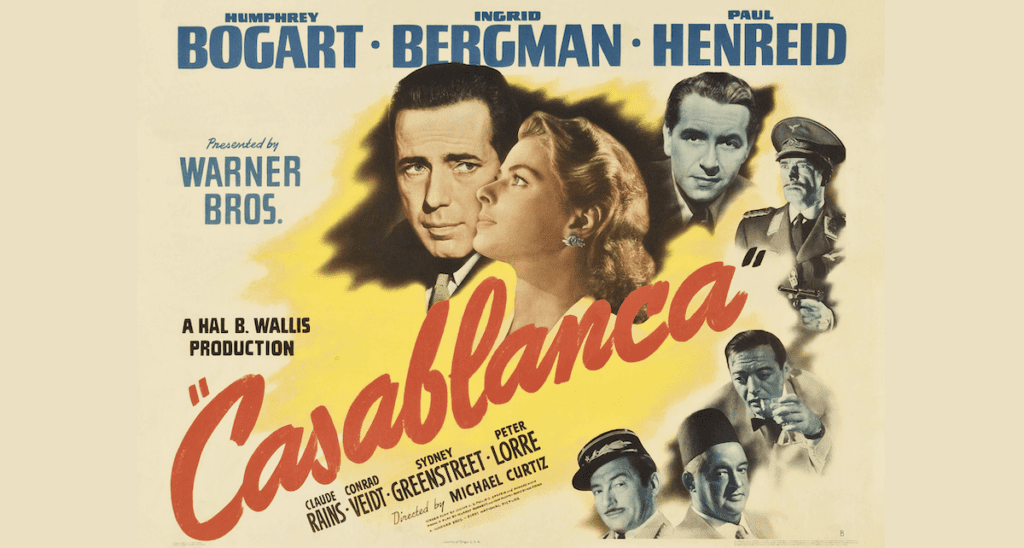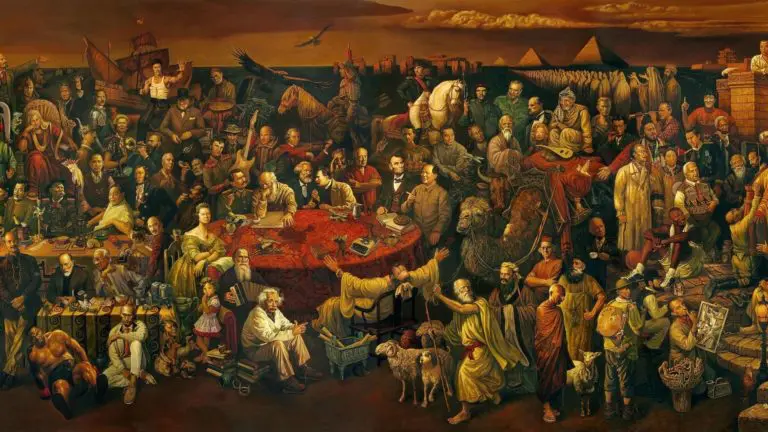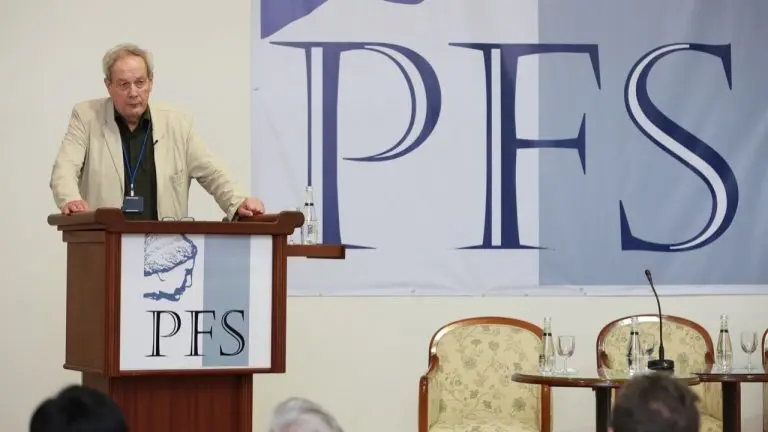Rarely have I read a more negative review than the one Umberto Eco prepared for Casablanca. Without any hesitation, the Italian author expressed his contempt for the most acclaimed American film of 1942 in the strongest terms. Referring to the same film, Roger Ebert saw in it a masterpiece—the opposite of what Eco saw. How is it possible for two authors of such stature to disagree to the point of contradiction?
Originally published in a collection of essays titled On Signs (1985), edited by Marshall Blonsky, Eco’s article is named “Casablanca, or the Clichés are Having a Ball.” Despite the cleverness of his title, the signs of catastrophe are already visible; for, in artistic terms, the notion of “cliché” is nothing more than the harbinger of an official death. The introductory paragraph does not end well and Eco announces that, from an aesthetic point of view (but also from any other critical perspective), “Casablanca is a very mediocre film.”
Struck by lightning, one can’t help but read further. Almost immediately follows an equally categorical statement that “Stagecoach is a masterpiece in every respect.” Wouldn’t it have been easier for Eco to tell us that he liked Stagecoach but not Casablanca? No way! He is not content just to make his opinion heard, leaving you the freedom to listen or run away, but, convinced of his own infallibility, he wants to chain you to his own ideas and convictions. So be it!
The inflation of archetypes
Maybe a little bit irritated, I continued reading. At first, Eco expresses amazement at the reactions of students everywhere. They, he tells us, never miss an opportunity to cry out in delight when they contemplate the characters of Humphrey Bogart, Ingrid Bergman, and Paul Henreid. The question naturally arises: what could be the secret of the fascination with Casablanca?
According to the legend of the film’s creation, Mihály Kertész (Michael Curtiz) improvised without much idea where it would lead. Possessed by the spirit of creative spontaneity of Tristan Tzara, he applied not just one or two, or even a few “eternal archetypes,” but a plethora of such narrative golden keys. Thus it happens that Casablanca “uses them all.” Eco enumerates the numerous structures camouflaged behind the scenes and the chained themes that transformed the script into an overwhelming “orgy of sacrificial archetypes,” or—somewhat less vulgarly expressed—into a “dance of eternal myths.” Very well; the abundance of archetypes is to blame. Why should we be upset with Eco if he sees what his knowledge allows him to see?
First, the pejorative epithet of “clichés” that he attributes to the aforementioned “archetypes” would rightly have made Vladímir Yákovlevich Propp, Mircea Eliade, and Northrop Frye frown. Such a hermeneutic of suspicion reveals the hostility of a postmodernist writer towards eternal Ideas. He believes that Casablanca, a film composed of a multitude of strong essences extracted from all imaginable films, “unfold with almost telluric force the power of Narrative in its natural state, without Art intervening to discipline it.” Maybe; after all, Eco is the master par excellence of narrativity, isn’t he? His conclusion implacably follows:
When all the archetypes burst in shamelessly, we reach Homeric depths. Two clichés make us laugh. A hundred clichés move us. For we sense dimly that the clichés are talking among themselves, and celebrating a reunion.
Consider Eco’s mention of the father of universal literature, Homer, the master of James Joyce and the Cohen brothers. Have you heard any critic, historian, or ordinary reader say that the beauty of Homer’s Odyssey results from the abundance of themes and myths? —That the “eternal archetypes” (how beautifully Eco puts it!) overwhelm readers? Consider other authors, other books, other movies. Is The Leopard by Prince Giuseppe Tomasi di Lampedusa brilliant because of its use of archetypes? Or—perhaps—is this the case of Luchino Visconti’s sumptuous adaptation? I could go on expanding the list indefinitely. But I will not be able to draw the conclusion that the accumulation of archetypes in a film or novel will give beauty to that creation.
That being said, I will shift the focus from the criticism of Eco’s critique to an approach to film that might be much more fruitful for all of us. First, I will note that an “over-saturated” view of the myriad archetypes he identifies in Casablanca could itself be the source of his reaction. Perhaps everything Eco sees is only in his eyes, in his mind. From there, through a process of “electron bombardment,” they have been projected onto the film that made him see black and white in front of his eyes. The abundance of his own ideas made him unable to perceive anything other than the pre-existing content in his wandering soul. In one word, it blinded him.
Sand in the eyes
A grain of sand entering the eye is enough to obstruct our vision. More grains would blind us. Not only do our eyes well with tears, but we cry as if our hearts were at the mercy of the dust that attacks us. The same thing happens with our presuppositions that make up the “filters” through which we view the world. We end up unable to see things around us clearly, without distortions. We view everything—as T.S. Eliot says in “The Frontiers of Criticism” (1956)—“only with eyes clouded by prejudice.” And the fact that God maintains the world in existence—making it appear, every moment, alive and fresh—is strange to us. We are like the inhabitants of a medieval city preserved almost intact to this day, like Carcassonne. Seeing it day by day, with the same “dusty” gaze, it seems banal. The same thing can happen to locals who pass daily in front of Etruscan, Celtic, or Roman ruins lost on the streets of some Italian burg, without realizing that they are, in a mysterious way, contemporaries of Homer, Cicero, or Dante. How can the dusty gaze be “cleansed” or “purified”?
Edmund Husserl (1859–1938) struggled to answer this question. He managed to reject not only the giants of naturalism and psychologism but also those of logicism and Hegelianism. In the end, he managed to outline the steps of a method that—although it left some exegetes entangled in the net of his (sometimes) unclear texts—provided me with clues for a concrete approach to any aesthetic creation. Thus, during a Phenomenology course, I came to apply a kind of improvised phenomenological method to the most diverse aesthetic objects: films, poems, and electronic games. The fact that some of my students were able to analyze the ecstasy scene from Andrei Tarkovsky’s film Solaris (1972), or the short, animated gem Father and Daughter (2000) by Michaël Dudok de Wit, gave me wings. Does it truly work?
If an image is worth a thousand words, then a phenomenon is worth much more than that—at least, that’s what Edmund Husserl believed. Regardless of the kind of creation of the human spirit with which we are dealing—a film, a novel, a symphony, a poem, or a painting—first and foremost, we must distinguish that thing which Husserl called “phaenomenon.” So what is the phenomenon? The film itself, of course, but what is “the film”? I propose a simple definition: the film is the “motion picture” offered to be watched on the precisely delimited space we call the “screen.”
Perhaps somewhat vaguely, the film as a phenomenon reminds one of what the Romans called a templum: a space circumscribed and separated by priests from the rest of the land. Imagine, for example, the frame of a painting without content—just the frame—through which you would gaze into the sky. That space would be the templum once consecrated by priests. However, in the case of film, the templum is not a sacred space, but a delineation that allows the focus of attention of those who look towards the content that is shown. In the case of any cinematic creation, this content is the “phenomenon.”
Once we have delineated the “thing itself” (i.e., the “phenomenon”) that is offered to us in the experience of contemplation, we venture into the phenomenological jungle. We can’t do it without a machete. If there is something characteristic of the method proposed by Husserl, it is reduction. Its sharp blade is an invaluable aid. That’s exactly what Umberto Eco lacked when he got tangled in the lush forest of archetypes.
The notion of “reduction” refers to what in some Husserlian texts is called “bracketing”—a setting aside of the prejudices with which the viewer encounters with the film. At other times, it seems to be assimilable to a notion borrowed by Husserl from the Greek skeptics, epoché: cessation, withholding of assent. The attitude by which we suspend our prejudices is an act of “reduction” or “setting aside” of the cultural-intellectual baggage with which we approach the encounter with the film. We do that by becoming aware of their existence and the “filter” created by them.
As for films, prejudices are often as severe as the repulsive reactions we have when we discover a bug on our plate. I don’t exclude the natural reaction to kitsch and scandalous creations, but it can also be the response of an inflated subjectivity. Today, egocentrism is so widespread that it plays tricks on us. How do we distinguish it from the reaction to kitsch? Very simply! When someone tells me that roses are ugly because he prefers lilies, that is the result of a prejudice (because both roses and lilies are beautiful). Similarly, some people excommunicate entire genres of creations—Westerns, comedies, sci-fi, or fantasy—under the accusation that they are commercial, non-artistic movies. Whatever the nature of the grains of sand that obscure our vision, they must be removed. Specifically, Husserl asks us to take our limitations seriously, to reflect, and to realize that they exist.
I’m sure critics like Eco will have the hardest time. With their heads full of many sophisticated theories, they cannot watch a decent film and enjoy its qualities like an ordinary spectator: to see, to listen, and to relax without explaining, without rationalizing, and without speculating like Kant and all the metaphysicians after him, who cannot see the sky without writing another treatise; and all this while being aware of and reflecting moderately on the experience they are having. No, I am not a follower of the “philosophy of the moment.” Neither was Husserl. His ideas can be understood as an invitation to be less of the “brain” or “reason” that analyzes, dissects, and judges, and more of the “eye” or “heart” that watches and feels.
When the movie Casablanca begins, the music enthralls us. The discreetly oriental atmosphere blends with the names that have immortalized a fragment of the turbulent years of the Second World War. Following in the footsteps of immigrants, we traverse the European routes that lead to Morocco. Gradually, we immerse ourselves in the crowded landscape where life follows its course. If at first the narrator’s voice was a guide, now different scenes, apparently unrelated to each other, introduce us to an atmosphere full of the hopes and futile dreams of those who want to escape to America. Without demands, without prejudices, and without expectations, we watch. We are eyes and ears. As spectators, our merging with what is shown on the shiny surface of the screen is increasingly intense. We almost don’t realize whether the movie is within us or we are within it. For lovers of scholarly explanations, I am content to tell you that this happens because that screen represents the external projection of the inner screen on which the perpetual phantasms of imagination unfold.
If we manage to “bracket” our cultural baggage, whatever its nature, we can be “transported” into the film without our own internal filter overshadowing the “phenomenon.” Eco failed because he never once experienced a life experience like the experience he had while watching Casablanca. He acted like a blacksmith who, instead of being amazed by the music of a soloist who is playing a Paganini piece on the violin, was obsessed with the nature of the metal used to make the strings. Instead of calmly contemplating the film, he counted archetypes and made lists. In so doing, he could only lose sight of the “charm”—the first ingredient of any artistic creation.
The Heart of the matter
If Eco had managed to detach himself from his analytical attitude, he would have participated in the lives of the characters. The dialogue, the gestures, the lights, even the shadows—in a word, everything, would have led him to what Husserl sought in phenomena: “the essence,” the heart of things. I won’t draw you into the labyrinth of questions and speculations about their “place” in the director’s mind, in the minds of the spectators, in the subject and in the object (or perhaps in both). Nor will I open the Pandora’s box of endless discussions about noumena, intentionality, noesis and noema, or other complicated phenomenological concepts. However, I will touch upon the essence of the film, which, at the same time, is invisible and visible, is here and there, is obscure and yet accessible.
Absorbed in the tumult of the story, the spectator quickly understands with what he is dealing: love. We find ourselves in the midst of a Symposium—whether Platonic or not. Rick, Ilsa, Victor, and all those around them embody the eternal tale of forbidden love. “Well, what’s the big deal?” skeptics will scoff, “Isn’t that what many stories, poems, ballads, paintings, and films created from the beginning of the world until today are about?”
In the case of Casablanca, the apparent essence has a deeper, more elusive core. At first glance, prejudiced by movies that hastily repeat the same “recipe” without paying attention to details, we seem to have a romantic story like so many others. That would be nothing in a world where that dangerous “love-passion,” unmasked by Denis de Rougemont in his brilliant monograph Love in the Western World, is the most worshiped goddess. However, Casablanca shatters this idol. For the happy ending does not belong to the lovers, but to the spouses who, aided by a gentleman adventurer—a plausible hero named Richard Blaine—will remain united both in marital bed and in the ideal of freedom for which the legendary leader of the resistance, Victor Laszlo (the husband of Ilsa Lund) was ready to give his life. It’s not about passion-love, but about pure, altruistic love, animated by the aristocratic spirit of sacrifice so rare in twilight epochs. Perhaps this is precisely the essence of the phenomenal phenomenon that still makes young people in movie theaters shout with delight.
How did Eco miss it? It’s easy to lose sight of the forest for the trees. Dizzy with the “archetypes” in his mind, and brimming with theories, Umberto Eco wrote a bitter review instead of simply saying, “I didn’t like it.” We shouldn’t have been too surprised. Sometimes, sophisticated postmodern spirits cannot taste the simple joys of a story with Prince Charmings and Cinderellas who live for others, rather than for their egos inflated to cosmic proportions. That’s why I believe we are enchanted by Casablanca, a cinematographic creation whose essence has been liberated from the tyranny of the daimon Eros.






